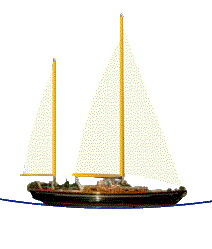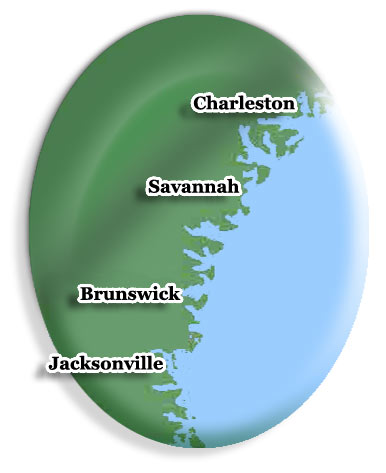
Ships Log
November 19-21, 2005
Miles 202 - 463
Coastal Sail Offshore Beaufort, NC to Charleston, SC
We left Beaufort Harbor before light and with excited anticipation of our first extended coastal sail. The forecast was for 15-20 knots of wind from the NNE and the wind was to moderate as we traveled southward. Our destination of Charleston was 260 miles distant (anchorage to anchorage) and we estimated that it would take us 35 to 40 hours.
As we worked our way out to the Atlantic, we passed closely to the Rachel Carson Wildlife Refuge. In the dim predawn light, we could see several wild horses on the beach. These beautiful creatures are descendents of mustangs that came ashore from the wrecks of Spanish ships centuries ago. The 35 degree temperatures caused steam to cloud from the horses noses. As we reached the ocean, we were presented with a dawn over the Cape.
We sailed SSW beyond the horizon offshore. The watch schedule was three hours on and three hours off. This gave us sufficient break for sleep unless there was an emergency that called for "all hands on deck". On Mike's first watch, he noticed the dark blue of the waters with brilliant white breakers. This was a striking contrast to the reds and golds of the ICW tannin laced waters. At 8:30 AM, Mike saw a spout one to two miles distant in the east. Whales! The Coast Guard had warned of a large migration of Right Whales heading down the coast. The English whalers had named these the Right Whales, because they were the perfect target and easy to kill. Over harvesting had dangerously depleted these and many whale species until international conventions protected the intelligent beings.
On Rana's first watch, she saw a giant sea turtle. During a change of watch in the afternoon, we both witnessed the arrival of fellow travelers who played in our bow wave off and on for the rest of the trip. The porpoises traveled in pods of four to six. The adults were dark grey on their dorsal side with mottled light grey to white underbellies. The young were entirely dark grey, nearly black. Most of the time, they would charge to the boat with strong thrusts of their tails and then frolic in the bow wave. They are the perfect swimmers and extremely graceful in their motion. The young are a bit more exuberant. They would often jump completely free of the water. On the second day, when the waves were much higher, they would take a long run and shoot from the top face of a large wave, seeking maximum "air" before landing with little regard for form. Unfortunately, the conditions were such that we could not use the camera since waves would sometimes break into the cockpit.
During the night watches, we had two close encounters with freighters. Our radar tracked them on collision courses. Evasive actions did not seem to be enough to avoid a close pass. In each case, we called the vessel on the radio. It is best to let them know that you are there. The first freighter responded in Spanish with a lot of excited yelling. We have got to learn the language! Eventually, they brought an English speaking crewmember to translate. We announced our latitude and longitude and when they found us, we altered to an agreed course. Rana's offwatch rest was interrupted to handle the communications since Mike had his hands full with the helm and radar in the growing winds and seas.
The moon and stars had been blotted out by
the storm and it was a very black night by the time the second freighter
appeared on the radar screen. Mike just could not bring himself to rouse
the exhausted
Rana again, and tried to raise the freighter on the radio. There was no
reply to his repeated calls. It was obvious that the freighter did not see
us and it closed to less than a mile. It was difficult to sufficiently change
course in the storm, but we tried to sail at right angles to the projected
freighter course. Finally, Mike was able to get the attention of the freighter
by shining our million candle power spot light alternatively on our sails
and the freighter's bridge. It is much too close when you can do that! There
was still no reply on the radio, but the freighter changed course and the
encounter ended. It may have been another example of a communication problem.
Lessons: learn Spanish (especially sufficient terms for such
maneuvers), keep the spotlight charged and at hand, keep an additional handheld
radio charged and at hand in the cockpit. Luckily, we do the latter
two religiously.
The approach to Charleston, SC was in slightly more settled conditions as we passed Ft Sumter, but a really big blow was forecast to arrive at any time. We are learning that weather forecasts are not as reliable here as in the Great Lakes. Night was falling as we avoided the harbor freighter traffic and proceeded up the Ashley River to the City Dock. To date in our travels, we had been well behind the southward boat migration and it was easy to find slips and anchoring spots. However, our offshore hop had brought us into the center of the crowd and there were no slips available and the anchorage was very crowded.
We were tired. We explored the end of the anchorage near the Coast Guard station and determined that any remaining spots were way too close to the station. Mike put the boat in reverse to back out into the channel and all hell broke loose. It was quickly apparent that we had backed over a trailing line and wrapped the prop. Two things had to be done immediately: (1) shut down the engine to avoid damage to the engine, prop and shaft, and (2) drop the anchor so that the swift tidal current did not sweep us into the Coast Guard station. Mike was too tired to notice the trailing line in the dark, but still quick enough to get these tasks accomplished rapidly.
We were too close to the Station to deploy more than 40 feet of chain. This was in 30 feet of water, in a strong current and with a very strong blow coming. So, we launched the dingy, loaded in our second anchor and rowed out 100 feet of rode plus 40 feet of chain. There was not time to affix the outboard motor and the row was challenging since the current pulled the rode in a long arch downstream. However, we got the second anchor deployed just as the 50+ knot blow hit. We called the Coast Guard station to report our proximity to their dock and ship. We repeated the call for each shift change because we had been informed that the Guard has new procedures calling for swift and aggressive action when unannounced boats ventured close. We thought we had enough to handle without that.
Now it was time to don the wetsuit ala Jacques Cousteau and cut the line from the prop. We did not have an underwater light, so we rigged a flashlight in a plastic bag. Mike went over the side into the cold water. However, he found that the current was way too strong to complete the task and it had to wait until morning slack tide and light. Jacques would have been disappointed. We maintained an all night anchor watch to make sure we did not drag. The main anchor on the short rode did drag, but the second anchor held.
In the morning, we called Boat US and had a diver clear the prop for free (thank you Boat US Towing Service Insurance - $100 annually for unlimited coverage). Lessons: assume that the weather will be worse than predicted, buy underwater light, have anchor ready for immediate deployment when in situations that may require it, have a second anchor readily available, contact Coast Guard when near station, and buy towing insurance.
In the middle of all this, Rana had the forethought to make a reservation for a slip at the City Docks, so we went to the Mega Dock in the morning. The weather continued to be challenging and we had the option of taking an easy to approach and depart spot on the outer dock, or one on the inside which was more protected but very difficult to maneuver into in the congestion. We were glad we went to the protection because it blew like snot for days!
The City Dock offers free van shuttles to West Marine and downtown and we took advantage of both trips and took the easy 2 mile walk to town a number of times. We bought a sweetgrass and palm basket and learned of the local culture from the basket weaver. We walked through the ancient Charleston Cemetery, and visited the old Customs House located on Broad and Meeting Streets. That night, we went to see Harry Potter at the IMAX and then walked along the Cooper River viewing the Charleston Bridge.
The City Dock holds a number of beautiful boats including Raven, Meriah, Mar, and When and If . We celebrated Thanksgiving aboard Raven with our friends Nicky, Larry and Victoria from the Canadian ketch Meriah.


